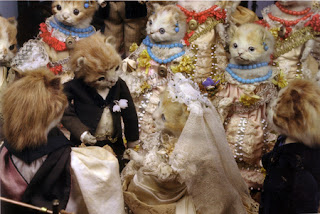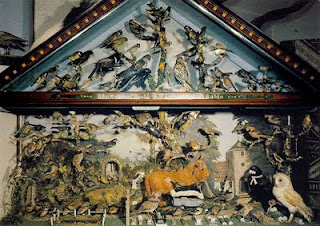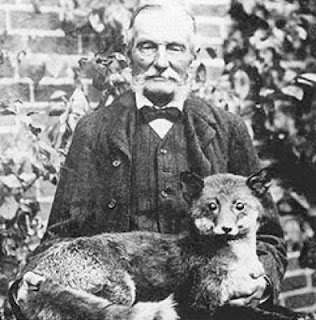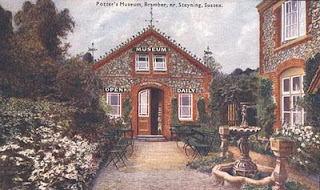 |
| The Kitten’s Wedding |
Until his death in 1918, Walter Potter created numerous scenes from everyday domestic life – a cricket match, a tea and croquet party, a wedding, a schoolroom – using taxidermied guinea pigs, rabbits, kittens, squirrels, and other small birds and animals, all of which were on view at Potter’s Museum in Bramber, West Sussex. While now-a-days Potter’s use of animals would draw a hue and cry from activists, one cannot deny that the collection is a wonder and that it offers a view on Victorian ingenuity.
 |
| The Bride |
The eccentric world of taxidermist Walter Potter, where stuffed animals mimic human life, occupied various homes after Potter’s death, one of them being Jamaica Inn in Cornwall. However, the 10,000 item collection was broken up and sold for more than £500,000 in 2003. Many people were outraged that Potter’s historic dioramas were not kept together, but the quirky display is being reassembled in an exhibition at the Museum of Everything in Primrose Hill, London co-curated by artist Sir Peter Blake.
 |
| The Death and Burtial of Cock Robin |
Walter Potter was born in a small English village called Bramber, near Steyning in West Sussex on the 2nd of July, 1835, his family ran a local public house in the village called The White Lion (now believed to be known as ‘The Castle’). At the age of 15, Walter made his very first attempt at taxidermy when he preserved his own beloved pet canary. Walter told the story of how this led to bigger things for him to a correspondent from The Idler Magazine in 1895 –
“Well, after I’d done my canary, people encouraged me to persevere. If they saw any bird or animal they thought I would like, they’d bring or send it to me. At last I get the idea of putting a case of birds together to illustrate ‘ The History of Cock Robin.’ It took me all my spare time for over six or seven years, and I used over a hundred specimens of British birds, including, though not actually necessary to the story, the cuckoo, nightingale, goldfinch, hawfinch, bramblefinch, and buntings. I also threw in a few butterflies. The bull himself was the most difficult of all. At last I bought a model, as it was impossible to get a real bull, however small, into the case. When I had bought my model it hadn’t any hair or skin, so I got a calf-skin, cut the hair off, and stuck it on the model with glue. When I had finished my ‘ Cock Robin ‘ cage I was living at the Castle Hotel here, and exhibited it in the garden bower. All the young ladies from the school here came to see it, and one of them took her hat off and collected a few shillings from her companions. From that time I gradually began to keep a collection. I never thought, when I started, to make a Museum, but the thing gradually grew of itself. Soon I began to want more room. My father had a new tea-shed put up in the garden, and so I used that as a show-room.
 |
| Walter Potter and a Friend |
Soon Walter needed to move his experiments of preservation, to the stables loft as his interest and hobby grew. As legend has it, he was inspired by his sister, Jane Potter, who showed him the illustrations in her nursery rhyme book, he took particular interest in the well known rhyme, ‘The death and burial of cock Robin.’ Potter was thus prompted to produce his most famed diorama, which included 98 species of British birds housed in a large glass case.
The tableaux went on display in a summer house in 1861 behind his parents inn and was a huge success with received commissions to create taxidermy animals for wealthy Victorians. Before long, Walter discovered he could make a living via taxidermy and at the same time fund his passion for his more creative dioramas/tableaux, for which he was to become famous.
After several moves of premises, likely to have all been in Bramber, in 1880 Walter secured a specially constructed building, which soon had to be extended to include other unusual exhibits from the animal kingdom, such as the four legged chicken and the two headed lamb.
Walter married a local girl called Ann Stringer Muzzell and went on to have three children, Walter, Annie and Minnie all thrived as the museum grew in both size and popularity, coming to be known as ‘Mr. Potters Museum Of Curiosities’ and hailed as a ‘World Famous example Of Victorian Whimsy.’ At the peak of its popularity, special coach trips were laid on from Brighton and the Museum drew such large crowds to the village that an extension had to be built on to the platform at Bramber railway station.
Walter suffered a stroke in 1914 and never to fully recovered, dying in 1918 at the age of 83. He was buried in Bramber churchyard, in the little villiage in west Sussex that he had scarcely left. By this time the museum contained about 10,000 specimens.
 |
| Potter’s Museum, Bramber, Sussex |
The museum closed in the 1970s, and, after having been moved to Brighton and then to Arundel, was sold in 1984 to the owners of Jamaica Inn, Cornwall, where it attracted more than 30,000 visitors each year. The death of their taxidermist and economic considerations led to the collection being auctioned by Bonhams in 2003, when a total of £500,000 was raised. P
resent at the auction were Peter Blake, Harry Hill and David Bailey. A bid of GBP£1m offered by Damien Hirst for the entire collection had apparently been rejected by the auctioneers, and the owners sued Bonhams, arguing that this offer should have been accepted.
Potter’s taxidermy collection was broken up and taken to the four corners of the world by their new owners. However, right now the collection has once again been reassembled and will be exhibited at the Museum of Everything until the end of December. The iconic pieces, “The Kitten’s Wedding”, “The Kittens’ Tea Party” and “The Death and Burial of Cock Robin” will also be on display. James Brett, the Museum of Everything’s founder said : “Potter was . . . a true original and himself an outsider artist as much as a craftsman. I can tell a Potter from the work of another taxidermist at a glance across a room – he was a genius”.
Other loans for the exhibition come from the comedian Harry Hill, the photographer David Bailey, other passionate private enthusiasts, and Pat Morris, a retired academic and expert on the history of taxidermy who intends to leave his own collection to a museum. “The Death of Cock Robin,” which displays more than 100 birds including a weeping robin widow and an owl gravedigger who has tumbled some tiny bones out of the soil while preparing space for the dead robin. Phone calls were still coming in every day from Potter fanatics, according to Brett. The three-legged pig, the two-headed lamb and the four-winged chicken are already in place. He hopes the rabbits’ school, and the guinea pigs playing cricket, a piece believed to be in France, may yet turn up.
Saw the collection at Jamaica Inn in the 90's. Truly a marvel of industry and imagination. Though slightly weird and creepy!
Can you imagine all of that displayed in your house. I think it would be fascinating to see, but too much exposure to it might give me a serious case of the heebie jeebies!
I think it's creepy too. I could never get out of my mind how those poor little chaps met their deaths. Not suggesting Walter did them in (or did he help some of them along?) but what were they – roadkill?
I hate to point this out, but none of the poor things look like they've been run over. And they look like kittens, rather than old cats that died in their sleep. I'm thinking the less speculation the better!